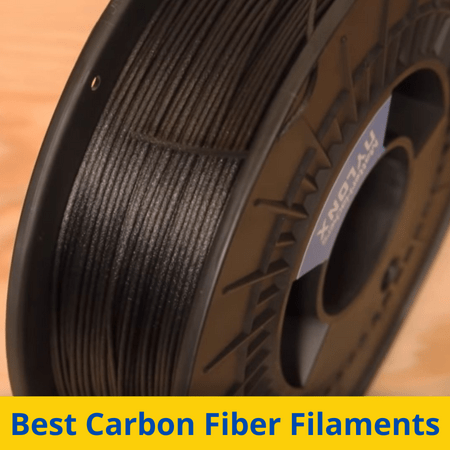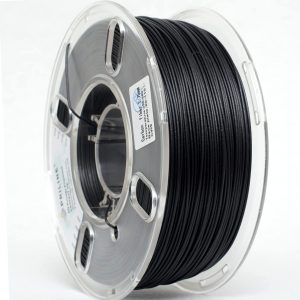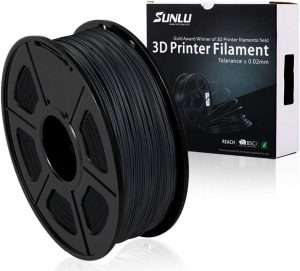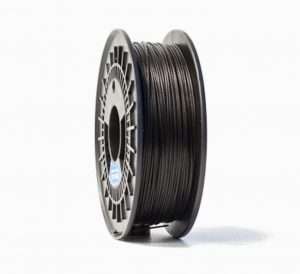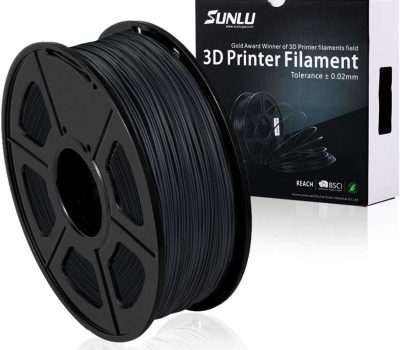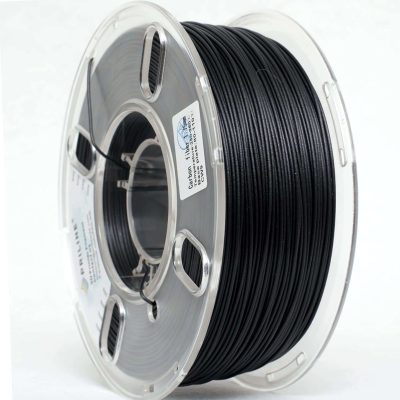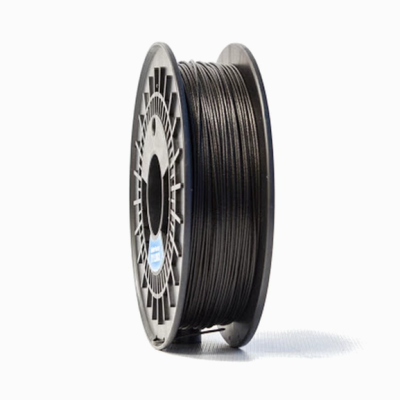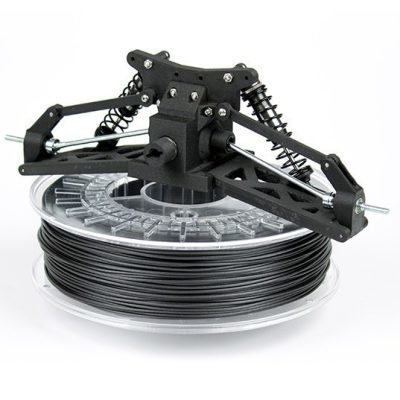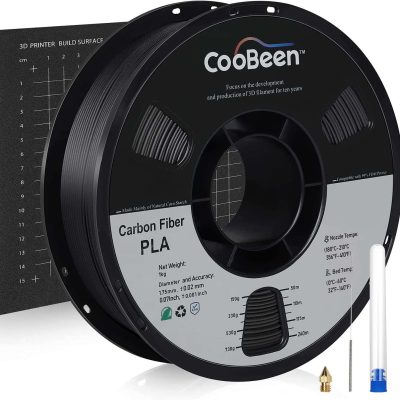- Last Updated: January 12, 2024
-
 Pat Nathaniel
Pat Nathaniel
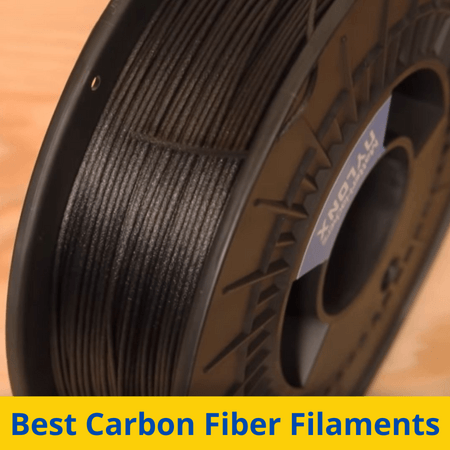 Do you feel the need for strength?
Do you feel the need for strength?
Carbon fiber filament lets your printer flex its muscles. With these materials, you can create prints that can withstand an earthquake — literally.
But the filaments aren’t made of pure carbon fibers. They’re mixed with other materials to make them printable, and that’s where things get confusing. You don’t want to waste money on filament that doesn’t serve your needs.
Read on to find out what is the best carbon fiber filament for your workspace.
Table of Contents
- Best Carbon Fiber Filaments At A Glance
- 1. Sunlu CF PLA (Best Choice)
- 2. Priline Superhard CF PC (Best Value)
- 3. MatterHackers NylonX CF (Premium Choice)
- 4. ColorFabb XT-CF20 (Best for Sturdy Prints)
- 5. CooBeen CF PLA (Quality Prints)
- Printing with Carbon Fiber-Reinforced Filaments
- What is Carbon Fiber Filament?
- What Do You Need to Print with Carbon Fiber Filament?
- Is Carbon Fiber Filament Strong?
- Ideal 3D Print Designs for Carbon Fiber Filament
- Print Parts That Won’t Give In
Best Carbon Fiber Filaments At A Glance
1. Sunlu CF PLA (Best Choice)
2. Priline Superhard CF PC (Best Value)
3. MatterHackers NylonX CF (Premium Choice)
4. ColorFabb XT-CF20 (Best for Sturdy Prints)
5. CooBeen CF PLA (Quality Prints)
There are a lot of carbon fiber filaments on the market. But if we had to pick only one, we’d pick Sunlu’s Carbon Fiber PLA filament.
It’s just an all-around great filament.
Sunlu CF PLA prints like a dream. It flows smoothly through the nozzle — no clogs or bubbles. There’s practically no warping and the final parts are strong and dimensionally stable. It makes high-quality parts easy, no matter what you print.
Layer adhesion is strong and the filament sticks to the print bed firmly, while still coming off easily once the part cools. A word of warning, though — don’t use a PVA glue stick on the print bed. Your parts might stick too well.
The filament and the carbon fibers are also 100% biodegradable. If you’re environmentally minded, here’s your filament.
All in all, Sunlu CF PLA is as solid as the parts it makes. It’s the single best carbon fiber filament we’ve found.
Pros
- Accurate and strong parts
- Prints with few clogs or problems
- Affordably priced
- Great print bed adhesion
Cons
- Perhaps too great print bed adhesion
- Varying quality between filament batches
“Best value” doesn’t mean “the lowest price.” A product with good value gives you the most bang for your buck. If you’re looking for the right balance of price and performance, Priline Superhard CF PC delivers in spades.
Parts made with Superhard are tough, as they should be. There’s next to no warping or shrinking, so they have excellent accuracy and consistency. Say goodbye to resizing parts by 1% before printing. Simply put, Superhard makes printing with carbon fiber filament very easy.
Maybe a bit too easy…
The filament is marketed as having a polycarbonate (PC) base, but it’s not pure PC. The printing temperature makes that clear — PC needs a nozzle temperature of around 570°F (300°C) but Superhard prints at 465-500°F (240-260°C).
So, what’s the mixed-in material, apart from carbon fibers? Priline doesn’t say.
But maybe it doesn’t matter. Priline Superhard CF PC is just a good deal in any case.
Pros
- Great price-performance balance
- No warping or shrinking
- Good nozzle flow characteristics
- Sharp details
Cons
- Not pure polycarbonate
- Needs fine-tuned printer settings
Nylon is already strong, high-detail material. But when you mix it with carbon fibers, you get a premium, engineering-grade filament. That’s what MatterHackers NylonX CF is.
NylonX contains 20% carbon fiber by weight, which results in parts with extreme durability. You can combine the strength with decent fine detail quality. This filament is a good choice if you’re looking to take your printing game to the next level with advanced materials.
But you have to treat NylonX right to get the best results.
Nylon naturally absorbs moisture from the air, which can lead to stringing, warping, and clogs. You must dry this filament before use and store it in a thoroughly sealed container. NylonX tends to string even when dry, but proper printer settings can mitigate that.
If you need a professional-level filament for strong parts, this is the best carbon fiber filament for you.
Pros
- Engineering-grade filament quality
- Produces very strong parts
- Smooth surface finish
Cons
- Engineering-grade price tag
- Prone to stringing
- Nylon needs drying before printing
Ladies and gentlemen, I give you — Arnold Schwarzenegger! Oh wait, no, it’s ColorFabb XT-CF20. An easy mistake to make since this filament is as strong as the Terminator.
XT-CF20 creates prints with extreme stiffness and heat resistance. It’s almost like this carbon fiber filament was made for functional parts. If you’ve been looking to print parts that don’t bend under pressure, here’s your choice.
But strong parts are rough parts, right?
No, not really. XT-CF20 is a PETG-based filament, so it has practically zero warping. It even handles bridging well, unlike most carbon fiber filaments. Strong and good-looking, what a package.
But since XT-CF20 is PETG, it’ll take some fiddling to find the right printer settings. Otherwise, the filament tends to ooze quite a bit.
ColorFabb XT-CF20 makes 3D printing like hitting the gym. You have to put in some effort, but in the end, your parts will be stronger than ever.
Pros
- Extreme part stiffness
- Handles complex shapes well
- Virtually zero warping
- Suits any printer with a hardened steel nozzle
Cons
- Prone to oozing
- Needs a slow print speed
- Finding ideal print settings takes time
- PETG absorbs moisture and needs drying
The strength of carbon fiber has a beauty of its own. But why settle for that? CooBeen CF PLA shows your parts can be tough and still look great.
This PLA carbon fiber filament has a very high dimensional accuracy of +/-0.02mm. In case you’re not that well-versed in 3D printing lingo, I’ll just say that’s really good. You’ll get sharp details, crisp edges, and that sleek, matte black carbon fiber look.
But it’s not all about the looks.
CooBeen’s carbon fiber filament gives parts a bit of bend, but that’s not necessarily bad. In fact, it can work to boost your parts’ impact resistance. It’s not as strong as ColorFabb or Sunlu, but still sturdy enough to hold up a shelf.
And then there’s the affordable price. The low cost probably explains the lower strength. But if your prints can look great for cheap, I’m calling that an acceptable tradeoff.
Pros
- Fantastic detail quality
- Produces smooth surfaces
- Cheap
- Comes with an extra nozzle and other goodies
Cons
- Not as strong as other listed filaments
- Why give a brass nozzle for a carbon fiber filament?
- Inconsistent surface finishes
Printing with Carbon Fiber-Reinforced Filaments
Carbon fiber filaments are an excellent option for printing sturdy parts. They are exceptionally strong while still producing decent to good detail quality.
But the best thing?
They’re relatively easy to use. With a bit of practice, even beginners can create prints with industrial-level strength.
But you do need practice. Knowing a bit about carbon fiber filaments is incredibly helpful when working with these advanced materials.
What is Carbon Fiber Filament?
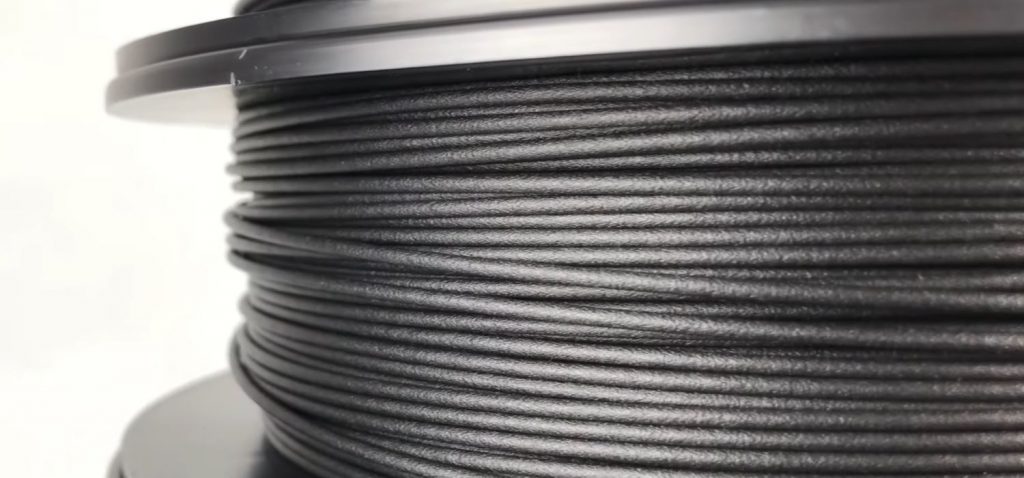
Carbon fiber filaments are composite materials. That means they consist of two parts — the base material and carbon fiber. Manufacturers mix carbon fiber into the base in varying ratios and extrude the mixture into the final filament.
Carbon fiber consists of carbon atoms bonded together into thin but long chains. Most carbon fiber filaments are chopped filaments, meaning the carbon fibers have been hacked into short bits for mixing.
Some carbon fiber filament brands use carbon fiber powder instead of chopped fibers. These filaments are usually cheaper but not as strong.
The base material will also affect the filament’s mechanical properties. Carbon fibers can be mixed into practically any thermoplastic (from PLA, PETG, PC, and Nylon) to create anything from carbon fiber PLA (i.e. Sunlu CF PLA), to carbon fiber PETG mix (i.e. ColorFabb XT-CF20), all the way to carbon fiber mixed with (i.e. MatterHackers NylonX CF).
The base determines the nozzle temperature you need to melt the filament, in addition to final print quality.
What Do You Need to Print with Carbon Fiber Filament?
Unfortunately, you can’t use carbon fiber filament with just any printer. You’ll need either a special carbon fiber 3D printer or a more general machine that has the right parts.
A hardened steel nozzle is the most important component you need. Carbon fibers are very abrasive and they’ll quickly chew through regular brass nozzles. Steel nozzles have high abrasion resistance that lets them withstand carbon fiber filaments.
Note that steel nozzles aren’t as thermally conductive as brass nozzles. You might have to raise the print head temperature a bit from the filament manufacturer’s recommendation to get the material flowing smoothly.
You should check your filament’s instructions for the ideal printer settings. But the average print settings for carbon fiber filament are:
- Nozzle temperature: 400-485°F (200-250°C)
- Bed temperature: 115-175°F (45-80°C)
- Print speed: 25-50% lower than recommended
- Build plate: Glass (potentially with adhesives)
Is Carbon Fiber Filament Strong?
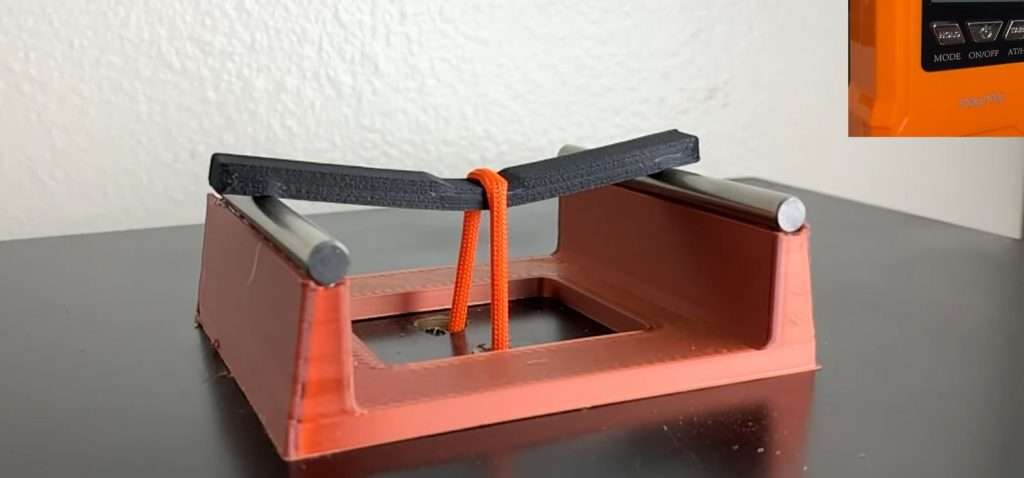
In short, yes. Carbon fiber-reinforced materials produce very strong parts.
But what exactly does “strength” mean here?
When talking about carbon fiber’s “strength,” people often actually mean rigidity. Printing with carbon filament results in extremely rigid parts. They have little to no flexibility — they retain their shape no matter how much stress they’re facing.
Of course, this means that carbon fiber prints won’t bend. When they reach a breaking point, they will snap cleanly into two.
The rigidity can be a blessing and a curse. More flexible materials, like PLA, might bend a bit upon impact and survive it, whereas a carbon fiber part could snap.
But that doesn’t mean PLA is stronger than carbon fiber — the best carbon fiber filaments can create parts that are even sturdier than metal!
Just like the moral of almost every kids’ story teaches you, strength is relative. But if you need parts that just won’t bend, carbon fiber is indeed one of the strongest materials you can print.
Ideal 3D Print Designs for Carbon Fiber Filament
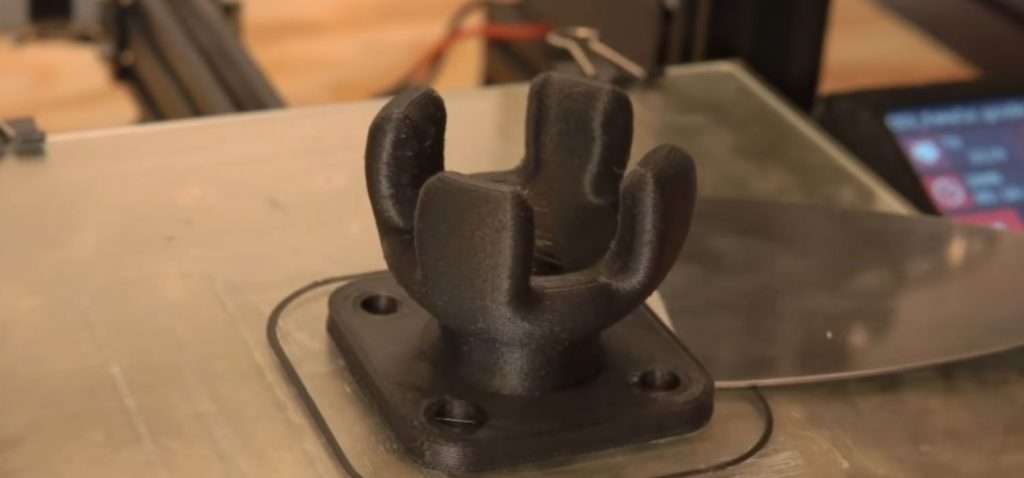
Thanks to its rigidity, carbon fiber is an ideal material for parts that need high wear resistance and dimensional stability. In other words, it’s great for parts that should never bend.
For example, carbon fiber filaments are particularly popular among RC car and drone enthusiasts. Its durability and light weight make it great for printing shells for these tiny vehicles. It’s also a great material for printing tools, like screwdrivers.
Other designs carbon fiber filaments are suitable for include:
- Supports of any kind
- Cases for electronics
- Tools
- Gears
- Propellers
- Car parts and accessories
Print Parts That Won’t Give In
Any of the filaments we’ve reviewed will produce sturdy and durable prints. But they are all slightly different, so pick the one that strikes the right balance between cost, strength, and detail quality for your needs. You’ll be set for strength for a long time.
But would you like to take carbon fiber printing to the next level?
In that case, consider amping up your game with a dedicated carbon fiber 3D printer. These machines are tailor-made to have the features carbon fiber filament requires.



